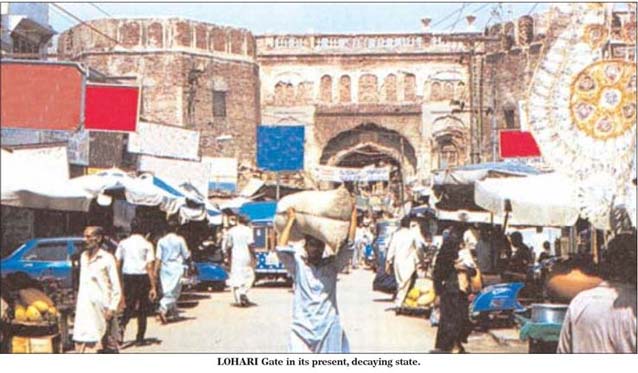Restoring the old city
By Saira Dar
Date:15-07-06
Source: Dawn
LAHORE is now a sprawling metropolis which continues to extend its boundaries by the day. New housing societies continue to emerge, tempting the people to live in these, hopefully, better planned localities, so that even many of the elite are now constructing their houses in areas hitherto unknown in the recent past.
However, when it comes to the need for an authentic feel of the city, or when nostalgia for the ‘real’ Lahore with its remnants of history and culture is invoked, it is to the ‘old city’ that many of us turn. The walled city continues to be of interest not only to tourists but to artists, architects, conservationists, intellectuals and all other individuals who value tradition, history and heritage.
Going to the walled city of Lahore is, of course, not without hardship and even heartache. What one sees and experiences is an ongoing process of unpleasant and downright vulgar and ugly urbanisation and commercial activity which continue unabated, without any sense of sensitivity to the ill-effects it is inflicted both in terms of aesthetics and living conditions.
Most of Lahore’s key Mughal monuments are located in and around the old city. The original nine-metre-high defence walls were built by the Mughal Eemperor Akbar which in his times, allowed daytime access to the city through 12 gates. These gates were later strengthened by the Sikh ruler Ranjit Singh. Only some of these now remain, and the city within has developed in an unruly fashion with the passage of time.
Lying to the northwest of the walled city are the famous Badshahi mosque and the Lahore Fort, both awe-inspiring in their plan and execution. Within the old city lies another exquisite example of architecture, the Wazir Khan mosque, and further to its west lies the well known Golden mosque. Both of the last mentioned may be approached via the Dehli Gate in the east of the city. The beauty of these monuments is nonetheless marred by ugly surroundings, including huge electricity poles and sprawling wires, haphazard encroachments and unruly vehicular traffic and pushcarts.
Amongst other attractions in the walled city are the Fakir Khana Museum, a private museum which houses artistic masterpieces, including paintings, sculptures, carpets, porcelain and ancient manuscripts. Then there is the haveli of Mian Salahuddin, now well known for hosting elite parties, and artist Iqbal Hussain’s Cuko’s cafe has become a popular spot, especially for entertaining out-of-town guests. The Chuna Mandi College for Girls has also shot into prominence because of the spectacular cultural programmes arranged on its premises.
Of commercial interest to many are the Kasera (brass) Bazaar, the Shah Alam market, Kashmiri Bazaar, Suha (jewellery) Bazaar, Dabbi Bazaar and Chhata Bazaar. However, owing to the haphazard mushrooming of shops and plazas which have taken the place of the old houses or havelis which were sold for to financial reasons and also the unlivable conditions of the area, the old city has become horrendously congested. The absence of any clear legal framework regarding encroachments has lead to a distressing scenario, which needs to be addressed with all seriousness.
Hopefully it is still not too late to counteract and tame the monsters of blind and insensitive urbanisation and to make a strong and effective attempt to conserve our heritage in a manner that is intelligent and impressive. A ray of hope in this regard, has emerged from the deliberations and goal identification by the Planning and Development Department of the Government of the Punjab which now appears to be making a serious effort to undo and stop the damage and deterioration rampant within and around Lahore’s walled city.
Backed by a generous funding by the World Bank, and the approval of the Punjab government, the project of ‘sustainable development of the walled city of Lahore’ seems to be one which may bring a significant and positive change in the conditions of the walled city, its heritage and also its inhabitants.
A recent invitation by the project director of the urban unit, Mr Nasir Javed, to attend a meeting regarding the aforementioned, where a presentation was made by the chairman of planning and development department Mr Suleman Ghani to a select gathering of local architects, artists and academics, conservationists, town planners and journalists brought into focus the multifarious problems rampant within the old city of Lahore, and the positive goals and objectives of the P&D in this regard.
It is heartening that such an effort is being made and that experts and intellectuals are being involved in the process. The task is a daunting one, and will be fraught with obstacles and resistance by those with vested interest. An intelligent and creative involvement of the people concerned is part of the agenda and it is hoped that many practical as well as inspiring solutions will be arrived at.
As identified at the meeting. There are other cities in the world such as Fez, Ahmadabad, Jaipur and others, which have benefited from similar projects aimed at conserving heritage and improving the conditions of the local populace. What, fortunately, has also been identified is that the uplift of old Lahore is not to be for just tourism reasons, but mainly for our own people who must be the main stakeholders benefiting from such an endeavour.
It is hoped that all those concerned with this project will help make it a success so that we can continue to be proud of our shared history and can savour its richness in present times and in the future.
